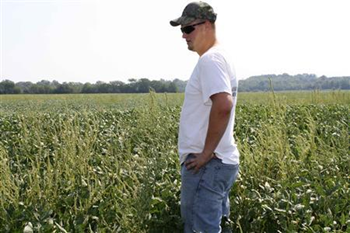 PAOLA, Kansas (Reuters) – Farmer Mark Nelson bends down and yanks a four-foot-tall weed from his northeast Kansas soybean field. The “waterhemp” towers above his beans, sucking up the soil moisture and nutrients his beans need to grow well and reducing the ultimate yield. As he crumples the flowering end of the weed in his hand, Nelson grimaces. “When we harvest this field, these waterhemp seeds will spread all over kingdom come,” he said. Nelson’s struggle to control crop-choking weeds is being repeated all over America’s farmland. An estimated 11 million acres are infested with “super weeds,” some of which grow several inches in a day and defy even multiple dousings of the world’s top-selling herbicide, Roundup, whose active ingredient is glyphosate. The problem’s gradual emergence has masked its growing menace. Now, however, it is becoming too big to ignore. The super weeds boost costs and cut crop yields for U.S. farmers starting their fall harvest this month. And their use of more herbicides to fight the weeds is sparking environmental concerns. With food prices near record highs and a growing population straining global grain supplies, the world cannot afford diminished crop production, nor added environmental problems. “I’m convinced that this is a big problem,” said Dave Mortensen, professor of weed and applied plant ecology at Penn State University, who has been helping lobby members of Congress about the implications of weed resistance. “Most of the public doesn’t know because the industry is calling the shots on how this should be spun,” Mortensen said. Last month, representatives from the U.S. Environmental Protection Agency, the Department of Agriculture and the Weed Science Society of America toured the Midwest crop belt to see for themselves the impact of rising weed resistance. “It is only going to get worse,” said Lee Van Wychen, director of science policy at the Weed Science Society of America. […]
PAOLA, Kansas (Reuters) – Farmer Mark Nelson bends down and yanks a four-foot-tall weed from his northeast Kansas soybean field. The “waterhemp” towers above his beans, sucking up the soil moisture and nutrients his beans need to grow well and reducing the ultimate yield. As he crumples the flowering end of the weed in his hand, Nelson grimaces. “When we harvest this field, these waterhemp seeds will spread all over kingdom come,” he said. Nelson’s struggle to control crop-choking weeds is being repeated all over America’s farmland. An estimated 11 million acres are infested with “super weeds,” some of which grow several inches in a day and defy even multiple dousings of the world’s top-selling herbicide, Roundup, whose active ingredient is glyphosate. The problem’s gradual emergence has masked its growing menace. Now, however, it is becoming too big to ignore. The super weeds boost costs and cut crop yields for U.S. farmers starting their fall harvest this month. And their use of more herbicides to fight the weeds is sparking environmental concerns. With food prices near record highs and a growing population straining global grain supplies, the world cannot afford diminished crop production, nor added environmental problems. “I’m convinced that this is a big problem,” said Dave Mortensen, professor of weed and applied plant ecology at Penn State University, who has been helping lobby members of Congress about the implications of weed resistance. “Most of the public doesn’t know because the industry is calling the shots on how this should be spun,” Mortensen said. Last month, representatives from the U.S. Environmental Protection Agency, the Department of Agriculture and the Weed Science Society of America toured the Midwest crop belt to see for themselves the impact of rising weed resistance. “It is only going to get worse,” said Lee Van Wychen, director of science policy at the Weed Science Society of America. […]
Analysis: Super weeds pose growing threat to U.S. crops
PAOLA, Kansas (Reuters) – Farmer Mark Nelson bends down and yanks a four-foot-tall weed from his northeast Kansas soybean field. The “waterhemp” towers above his beans, sucking up the soil moisture and nutrients his beans need to grow well and reducing the ultimate yield. As he crumples the flowering end of the weed in his hand, Nelson grimaces. “When we harvest this field, these waterhemp seeds will spread all over kingdom come,” he said. Nelson’s struggle to control crop-choking weeds is being repeated all over America’s farmland. An estimated 11 million acres are infested with “super weeds,” some of which grow several inches in a day and defy even multiple dousings of the world’s top-selling herbicide, Roundup, whose active ingredient is glyphosate. The problem’s gradual emergence has masked its growing menace. Now, however, it is becoming too big to ignore. The super weeds boost costs and cut crop yields for U.S. farmers starting their fall harvest this month. And their use of more herbicides to fight the weeds is sparking environmental concerns. With food prices near record highs and a growing population straining global grain supplies, the world cannot afford diminished crop production, nor added environmental problems. “I’m convinced that this is a big problem,” said Dave Mortensen, professor of weed and applied plant ecology at Penn State University, who has been helping lobby members of Congress about the implications of weed resistance. “Most of the public doesn’t know because the industry is calling the shots on how this should be spun,” Mortensen said. Last month, representatives from the U.S. Environmental Protection Agency, the Department of Agriculture and the Weed Science Society of America toured the Midwest crop belt to see for themselves the impact of rising weed resistance. “It is only going to get worse,” said Lee Van Wychen, director of science policy at the Weed Science Society of America. […]